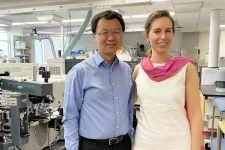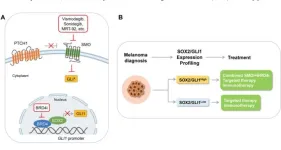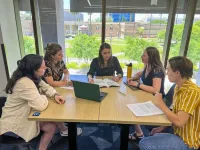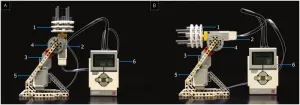(Press-News.org) Using an innovative method for measuring doctor turnover, Weill Cornell Medicine researchers determined that between 2010 and 2018, the annual rate at which physicians left their practices increased by 43 percent, from 5.3 percent to 7.6 percent a year. The causes of this trend are not known, but warrant further investigation, according to the researchers.
The study, published July 11 in the Annals of Internal Medicine, also found that the first three quarters of 2020 (the start of the COVID-19 pandemic in the United States) were not associated with higher turnover. However, more data are needed to fully understand turnover trends related to COVID-19.
Whether doctors are moving to a new practice or retiring, “it is important to study turnover because it can hurt the continuity and quality of patients care,” said one of the study authors Dr. Lawrence Casalino, professor emeritus of population health sciences at Weill Cornell Medicine. “There’s a lot of mutual trust that builds between a doctor and patient over time that’s difficult to replace.”
The study authors, led by Dr. Amelia Bond, assistant professor of health policy and economics in the department of population health sciences at Weill Cornell Medicine, developed a new method to estimate turnover primarily using the Medicare Data on Provider Practice and Specialty (MD-PPAS). This database contains information on clinician characteristics such as age and sex, physician specialty, and tax identification numbers of the practices in which physicians work.
Using this data, the researchers developed an algorithm allowing them to estimate physician turnover from 2010 through the first three quarters of 2020. “I think this method may become the gold standard to identify turnover in the years to come,” Dr. Casalino said, adding that prior estimates, using surveys to assess turnover, have been unreliable.
The researchers found that between 2010 and 2018, the annual rate of turnover, based on doctors moving or not practicing anymore, increased from 5.3 to 7.6 percent, a change of 43 percent. “While the percentage change from year to year seemed somewhat modest, the percentage change over time was quite large,” Dr. Casalino said.
Most of the turnover occurred between 2010 and 2014 and resulted from doctors who stopped practicing. Why turnover increased during those years remains unknown. “As we speculate in the article, those were the years when the electronic medical record became a requirement,” said Dr. Casalino. “Some prior studies have suggested a link between electronic health record use and physician burnout, and it may be that burned out physicians are more likely to stop practicing or move to another practice.”
Turnover may also create further barriers to accessing care for people living in rural areas and for underserved communities. The researchers observed that doctors in rural areas were more likely to move or to stop practicing medicine than urban doctors. Female doctors were more prone to turnover than male doctors. Physicians in larger practices were more likely to experience turnover than those in single-doctor or two-physician practices. Doctors who took care of more patients who were eligible for Medicare and Medicaid were also more disposed to turnover.
Following 2014, turnover rates remained stable through 2017, and then slightly increased in 2018. In the second and third quarters of 2020, turnover, which was based on data about moving, was slightly lower than in the corresponding quarters of 2019. While a great deal of turnover did not seem to be occurring early in the COVID-19 pandemic, “researchers need to look at the next year of two of data to get a better understanding of any pandemic trends,” Dr. Casalino said.
In addition to learning more about COVID-19 physician turnover, the method will also make it possible to determine how much turnover occurs after a private equity company, a health insurer, or a hospital acquires a physician practice.
“Once we know the reasons behind doctor turnover, individual practices or hospitals can better develop programs to retain their providers,” Dr. Casalino said. “That’s why we’re making our algorithm public for other researchers to use.”
END
Using new method, study highlights physician turnover trend
2023-07-19
ELSE PRESS RELEASES FROM THIS DATE:
Winery experiences affected by more than what is in your glass
2023-07-19
New research from the University of British Columbia's Okanagan campus has determined that enjoying a tasting at a winery goes well beyond the sip.
Professor Annamma Joy, with UBCO’s Faculty of Management, conducts research in the area of consumer behaviour and branding with a special focus on luxury brands, fashion brand experiences, wineries and wine tourism.
Dr. Joy, along with her collaborators and students, studied several Okanagan wineries over a three-year period to comprehensively document the experiences ...
Researchers use mass spectrometry to explore antimicrobial resistance
2023-07-19
Laura-Isobel McCall, Ph.D., and Zhibo Yang, Ph.D., co-principal investigators and associate professors of chemistry and biochemistry in the Dodge Family College of Arts and Sciences at the University of Oklahoma, have been awarded a prestigious R01 grant from the National Institutes of Health for their project, “Novel single-cell mass spectrometry to assess the role of intracellular drug concentration and metabolism in antimicrobial treatment failure.”
“Our project builds upon Dr. ...
Novel therapeutic strategy against melanoma: combined targeting of hedgehog signaling and BRD4
2023-07-19
“This evidence strengthens the relevance of the findings by Pietrobono et al., shedding light on the potential application of SMO inhibitors in concert with BRD4 inhibitors.”
BUFFALO, NY- July 19, 2023 – A new editorial paper was published in Oncotarget's Volume 14 on May 26, 2023, entitled, “Combined targeting of HEDGEHOG signaling and BRD4 as a novel therapeutic option against melanoma.”
The Hedgehog-GLI (HH/GLI) pathway is aberrantly activated in several types of cancer. Canonical HH/ GLI pathway is triggered by binding of HH ligands to the twelve-pass transmembrane receptor Patched 1 (PTCH1), which retrieves its inhibition ...
Large study finds small associations between systemic inflammation and later dementia
2023-07-19
A study of data from about 500,000 people in the UK Biobank has uncovered small but statistically significant associations between signs of systemic inflammation and later risk of dementia. Dr. Krisztina Mekli of The University of Manchester, UK, and colleagues present these findings in the open-access journal PLOS ONE on July 19, 2023.
Millions of people around the world have Alzheimer’s disease or other types of dementia, and researchers are working to tease out the complex mechanisms behind these conditions. Prior research has suggested that inflammation—activation of the body’s innate immune system—may ...
STEM instructors who are women drive disclosure of concealable stigmatized identities to undergraduates
2023-07-19
Women working as STEM instructors are more likely than men in the same profession to disclose to their undergraduate students identities which could carry stigma, such as depression or growing up in a low-income household. In the new study, published July 19, 2023 in the open-access journal PLOS ONE, Carly Busch of Arizona State University, USA, and colleagues suggest that these decisions to disclose may be in order to act as role models for students.
Concealable stigmatized identities (CSIs) are identities that ...
Researchers used a LEGO robotics kit as a cheap, effective way to purify self-assembling DNA origami
2023-07-19
Article URL: https://journals.plos.org/plosone/article?id=10.1371/journal.pone.0283134
Article Title: Gradient-mixing LEGO robots for purifying DNA origami nanostructures of multiple components by rate-zonal centrifugation
Author Countries: USA
Funding: The research in Hariadi lab was supported by the National Institutes of Health Director’s New Innovator Award (1DP2AI144247), National Science Foundation SemiSynBio II (2027215), and Arizona Biomedical Research Consortium (ADHS17-00007401). The funders had no role in study design, data collection and analysis, decision to publish, or preparation of the manuscript. END ...
A 300,000 year-old double-pointed wooden stick was produced by Middle Pleistocene humans using sophisticated woodworking techniques and was likely used for throwing during hunts
2023-07-19
Article URL: https://journals.plos.org/plosone/article?id=10.1371/journal.pone.0287719
Article Title: A double-pointed wooden throwing stick from Schöningen, Germany: Results and new insights from a multianalytical study
Author Countries: UK, Germany
Funding: T.T. and this project are funded by the Deutsche Forschungsgemeinschaft (DFG, German Research Foundation) – project number 447423357. https://www.dfg.de/. The project is further funded by the Lower Saxony Ministry for Science and Culture, with funds from the Future Lower Saxony Programme of the Volkswagen Foundation – project ...
1 in 5 rabbit owners in the UK report painful or debilitating ear disease in their pet, though it may be under-diagnosed and under-treated, with lop-eared and older rabbits being most at risk
2023-07-19
Article URL: https://journals.plos.org/plosone/article?id=10.1371/journal.pone.0285372
Article Title: Ear health and quality of life in pet rabbits of differing ear conformations: A UK survey of owner-reported signalment risk factors and effects on rabbit welfare and behaviour
Author Countries: UK
Funding: The authors received no specific funding for this work. M.R.D.K included some of this questionnaire in part-fulfilment of her Bachelor of Veterinary Medicine at Royal Veterinary College. ...
CHOP researchers reveal how NSAIDs worsen C. difficile infections
2023-07-19
Philadelphia, July 19, 2023—Why do nonsteroidal anti-inflammatory drugs (NSAIDs) exacerbate gastrointestinal infections by Clostridioides difficile, the leading cause of antibiotic-associated diarrhea worldwide? In a new paperpublished in Science Advances, researchers at Children’s Hospital of Philadelphia (CHOP) have begun to answer that question, showing that NSAIDs disrupt the mitochondria of cells lining the colon, sensitizing them to damage by pathogenic toxins.
Clostridioides ...
Early humans were weapon woodwork experts, study finds
2023-07-19
A 300,000-year-old hunting weapon has shone a new light on early humans as woodworking masters, according to a new study.
State-of-the-art analysis of a double-pointed wooden throwing stick, found in Schöningen in Germany three decades ago, shows it was scraped, seasoned and sanded before being used to kill animals. The research indicates early humans’ woodworking techniques were more developed and sophisticated than previously understood.
The findings, published today (Wednesday, 19 July) in PLOS ONE, also suggest the ...








